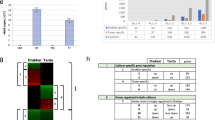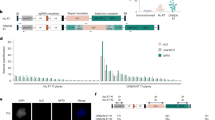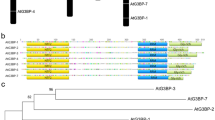Abstract
Plant genome stability is known to be affected by various abiotic environmental conditions1,2,3,4,5,6,7, but little is known about the effect of pathogens. For example, exposure of maize plants to barley stripe mosaic virus seems to activate transposable elements8,9 and to cause mutations in the non-infected progeny of infected plants10. The induction by barley stripe mosaic virus of an inherited effect may mean that the virus has a non-cell-autonomous influence on genome stability. Infection with Peronospora parasitica results in an increase in the frequency of somatic recombination in Arabidopsis thaliana11; however, it is unclear whether effects on recombination require the presence of the pathogen or represent a systemic plant response. It is also not clear whether the changes in the frequency of somatic recombination can be inherited. Here we report a threefold increase in homologous recombination frequency in both infected and non-infected tissue of tobacco plants infected with either tobacco mosaic virus12 or oilseed rape mosaic virus13. These results indicate the existence of a systemic recombination signal that also results in an increased frequency of meiotic and/or inherited late somatic recombination.
This is a preview of subscription content, access via your institution
Access options
Subscribe to this journal
Receive 51 print issues and online access
$199.00 per year
only $3.90 per issue
Buy this article
- Purchase on Springer Link
- Instant access to full article PDF
Prices may be subject to local taxes which are calculated during checkout


Similar content being viewed by others
References
Puchta, H., Swoboda, P. & Hohn, B. Induction of homologous DNA recombination in whole plants. Plant J. 7, 203–210 (1995)
Kovalchuk, I., Kovalchuk, O., Arkhipov, A. & Hohn, B. Transgenic plants are sensitive bioindicators of nuclear pollution caused by the Chernobyl accident. Nature Biotechnol. 16, 1054–1057 (1998)
Ries, G. et al. Elevated UV-B radiation reduces genome stability in plants. Nature 406, 98–101 (2000)
Ries, G., Buchholz, G., Frohnmeyer, H. & Hohn, B. UV-damage-mediated induction of homologous recombination in Arabidopsis is dependent on photosynthetically active radiation. Proc. Natl Acad. Sci. USA 97, 13425–13429 (2000)
Walbot, V. Reactivation of Mutator transposable elements of maize by ultraviolet light. Mol. Gen. Genet. 234, 353–360 (1992)
Walbot, V. UV-B damage amplified by transposons in maize. Nature 397, 398–399 (1999)
Kumar, A. & Bennetzen, J. L. Plant retrotransposons. Annu. Rev. Genet. 33, 479–532 (1999)
Dellaporta, S. et al. Endogenous transposable elements associated with virus infection in maize. Cold Spring Harbor Symp. Quant. Biol. 49, 321–328 (1984)
Johns, M. A., Mottinger, J. & Freeling, M. A low copy number, copia-like transposon in maize. EMBO J. 4, 1093–1102 (1985)
Brakke, M. Mutations, the aberrant ratio phenomenon, and virus infection of maize. Annu. Rev. Phytopathol. 22, 77–94 (1984)
Lucht, J. M. et al. Pathogen stress increases somatic recombination frequency in Arabidopsis. Nature Genet. 30, 311–314 (2002)
Harrison, B. D. & Wilson, T. M. A. Milestones in the research on tobacco mosaic virus. Phil. Trans. R. Soc. Lond. B 354, 521–529 (1999)
Aguilar, I., Sanchez, F., Martin, A., Martinez-Herrera, D. & Ponz, F. Nucleotide sequence of Chinese rape mosaic virus (oilseed rape mosaic virus), a crucifer tobamovirus infecting Arabidopsis thaliana. Plant Mol. Biol. 30, 191–197 (1996)
Burk, L. G. & Menser, H. A. A dominant aurea mutation in tobacco. Tob. Sci. 8, 101–104 (1964)
Shalev, G., Sitrit, Y., Avivi-Ragolski, N., Lichtenstein, C. & Levy, A. A. Stimulation of homologous recombination in plants by expression of the bacterial resolvase RuvC. Proc. Natl Acad. Sci. USA 96, 7398–7402 (1999)
Boyko, V., Ferralli, J., Ashby, J., Schellenbaum, P. & Heinlein, M. Function of microtubules in intercellular transport of plant virus RNA. Nature Cell Biol. 2, 826–832 (2000)
Dempsey, D. A., Shah, J. & Klessig, D. Salicylic acid and disease resistance in plants. Crit. Rev. Plant Sci. 18, 547–575 (1999)
Dong, X. Genetic dissection of systemic acquired resistance. Curr. Opin. Plant Biol. 4, 309–314 (2001)
Pearce, G., Strydom, D., Johnson, S. & Ryan, C. A polypeptide from tomato leaves induces wound-inducible proteinase inhibitor proteins. Science 253, 895–897 (1991)
Waterhouse, P., Wang, M.-B. & Finnegan, J. Role of short RNAs in gene silencing. Trends Plant Sci. 6, 297–301 (2001)
Karpinski, S. et al. Systemic signalling and acclimation in response to excess excitation energy in Arabidopsis. Science 284, 654–657 (1999)
Whitham, S. et al. The product of the tobacco mosaic virus resistance gene N: similarity to toll and the interleukin-1 receptor. Cell 78, 1101–1115 (1994)
Gorbunova, V. et al. A new hyperrecombinogenic mutant of Nicotiana tabacum. Plant J. 24, 601–611 (2000)
Acknowledgements
We thank S. van Eeden for technical assistance and H. Rothnie, K. Smith and E. Schultz for comments on the manuscript. The Novartis Research Foundation and Alberta Ingenuity Grant are acknowledged for financial support.
Author information
Authors and Affiliations
Corresponding author
Ethics declarations
Competing interests
The authors declare that they have no competing financial interests.
Supplementary information
Rights and permissions
About this article
Cite this article
Kovalchuk, I., Kovalchuk, O., Kalck, V. et al. Pathogen-induced systemic plant signal triggers DNA rearrangements. Nature 423, 760–762 (2003). https://doi.org/10.1038/nature01683
Received:
Accepted:
Issue Date:
DOI: https://doi.org/10.1038/nature01683
This article is cited by
-
Field application of nanoliposomes delivered quercetin by inhibiting specific hsp70 gene expression against plant virus disease
Journal of Nanobiotechnology (2022)
-
Methylome and transcriptome analyses of soybean response to bean pyralid larvae
BMC Genomics (2021)
-
Protocol development for somatic embryogenesis, SSR markers and genetic modification of Stipagrostis pennata (Trin.) De Winter
Plant Methods (2021)
-
Methylation Status of Arabidopsis DNA Repair Gene Promoters During Agrobacterium Infection Reveals Epigenetic Changes in Three Generations
Plant Molecular Biology Reporter (2021)
-
In Silico Analysis and Comparison of Pathogenesis-related Transcription Factor Binding Sites in Arabidopsis DNA Repair Gene Promoters
Proceedings of the National Academy of Sciences, India Section B: Biological Sciences (2021)
Comments
By submitting a comment you agree to abide by our Terms and Community Guidelines. If you find something abusive or that does not comply with our terms or guidelines please flag it as inappropriate.



